By Betty Resnick
Thanksgiving dinner is a special meal cherished by nearly all Americans. Gathering around the table, we give thanks for the abundance of a delicious feast. But, while millions of Americans look forward to their annual Thanksgiving meal, very few know about the amazing diversity of how and where most classic Thanksgiving foods are grown. In this Market Intel, we dive into the facts behind the production of nine Thanksgiving staples that are part of American Farm Bureau’s traditional Thanksgiving Dinner Cost Survey, which has been conducted annually since 1986.
To give a sense of the geographic diversity involved in producing your meal, we ranked the top three production states for nine Thanksgiving dinner staples: cranberries, celery, sweet potatoes, green beans, pumpkins, green peas, potatoes, carrots and turkey. A total of 15 different states appeared at least once in these rankings, representing every region of the country. From Massachusetts to California, Wisconsin to Mississippi – farmers across the nation work hard all year to grow the food we gather around and give thanks for on Thanksgiving.
Cranberries
The United States is the world’s largest producer of cranberries. Nearly all cranberries produced in the United States are processed into delicious and nutritious products including dried cranberries and cranberry juice. Famously, most cranberries are wet harvested – the beds are flooded, removed from the vine, then flooded again, during which the fruit floats to the top to be harvested. Fresh market cranberries are harvested in a drier, slower manner by being “combed” from the vines using a mechanized picking machine. Cranberries are a perennial plant, with the bush-like vines growing cranberries year-after-year in bogs.
Cranberries are native to North America and have a long history here, with cranberry sauce even being the suggested pairing with turkey in the first cookbook written by an American: American Cookery, published in 1796. The first commercial cranberry beds in the United States were planted by a Revolutionary War veteran in 1816 in Massachusetts on the Cape Cod peninsula. Today, the top states for cranberry production are Wisconsin (60% of domestic production), Massachusetts (26%), New Jersey (8%) and Oregon (7%).
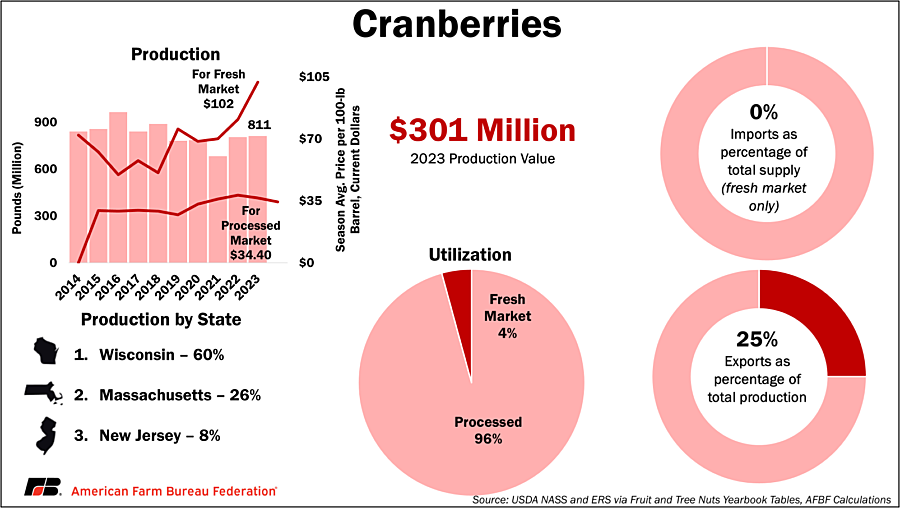
Celery
Today, most domestically produced celery grows nearly year-round on over 20,000 acres on the central and southern coasts of California. The state is so dominant in celery production that USDA’s National Agricultural Statistical Service only provides data for California-grown celery. Despite this reporting, growers in Michigan (1,100 acres) also produce celery. Most celery goes into the fresh market, and 86% of the celery supply in the United States is produced domestically.
Celery can be hand-harvested or mechanically harvested, but regardless of method it’s production is labor-intensive. Celery is a cool-season crop grown from transplants but can be grown year-round in California’s unique microclimates.
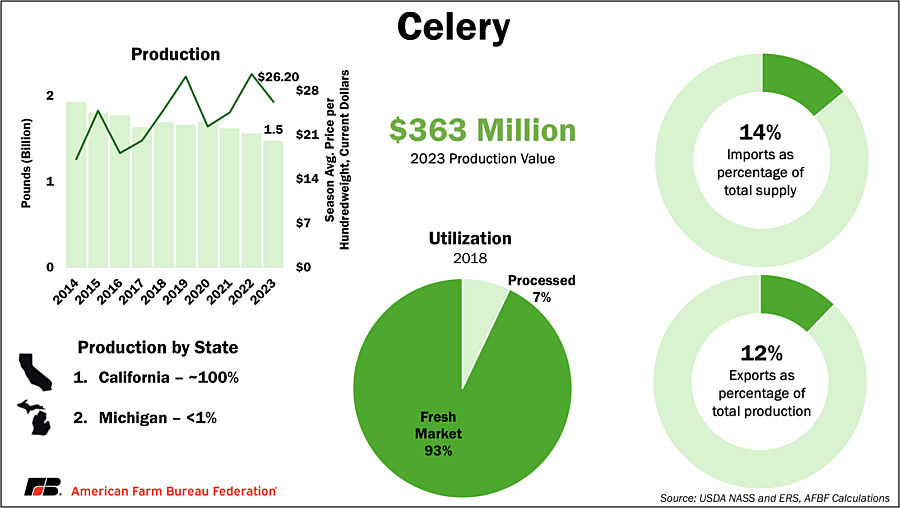
Sweet Potatoes
While sweet potatoes share a name with their other potato cousins, the production techniques and geographies of the two crops are very different. Sweet potatoes are primarily grown in the warm climates of North Carolina (60%), California (25%) and Mississippi (15%). The skin of sweet potatoes is delicate, requiring hand-harvesting or harvesting with minimal mechanization for sweet potatoes grown for the fresh market. This results in much higher labor costs than Russet and other varieties of potatoes that can be mechanically harvested.
Nation-wide, 78% of sweet potatoes are grown for the fresh market, but this varies quite a bit by region. Nearly all sweet potatoes grown in California go into the fresh market while nearly 40% of Mississippi sweet potatoes are processed. Thanks to innovations in curing and storage, sweet potatoes can be stored for a year – making them available domestically year-round and expanding export opportunities.

Green Beans
Green beans, also referred to as “snap beans” or “string beans,” are grown in a wide variety of states. While Wisconsin (46%) is the largest producer by a significant margin, remaining production is divided between Florida (13%), New York (12%), Michigan (7%), Oregon (6%), Illinois (5%), California (4%), Georgia (3%), Pennsylvania (3%) and Minnesota (2%).
Over 80% of domestically-produced green beans are processed through canning or freezing. Processed green beans are more likely to be harvested mechanically. Like many other crops, sometimes a combination of harvest methods is used. A first-round may be harvested by hand for the fresh-market, then a harvester will be used for a final pass for the processed market.
As fresh green beans are more labor-intensive to produce, they are more likely to be imported. While nearly half of all green beans sold fresh are imported, only 14% of the processed green bean supply is imported.
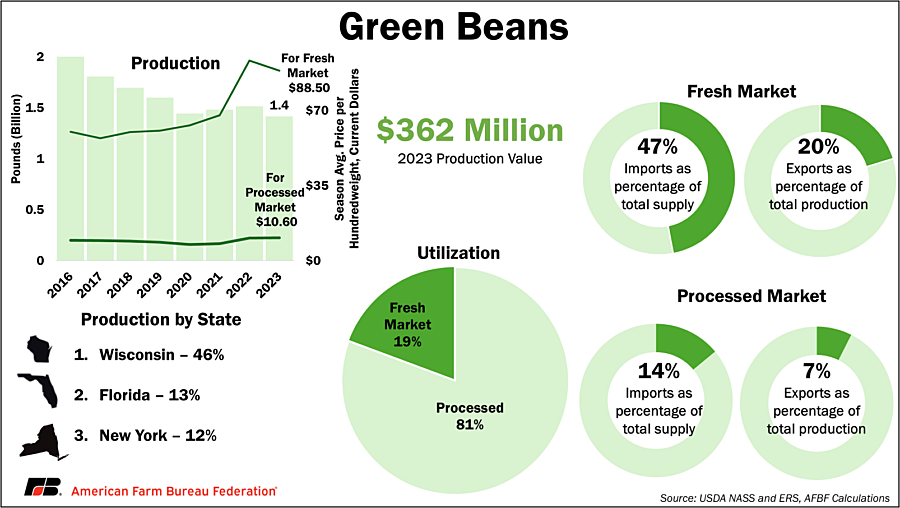
Pumpkins
Pumpkins have two different distinct markets: pumpkins for decoration (ornamental) and pumpkins for processing. Processed pumpkins are more yellow than traditional bright-orange ornamental pumpkins and are used primarily for canning. Illinois grows 98% of all pumpkins for processing in the United States, so when you are eating your favorite pumpkin treats, you can thank an Illinois farmer. Ornamental pumpkin production accounts for 58% of total production and is more geographically dispersed.
When combined, Illinois is the top pumpkin-producing state with 40% of all production, followed by Indiana (10%) and California (9%). Michigan, New York North Carolina, Ohio, Oregon, Pennsylvania, Texas, Virginia, Washington and Wisconsin each account for 5% or less of national production.
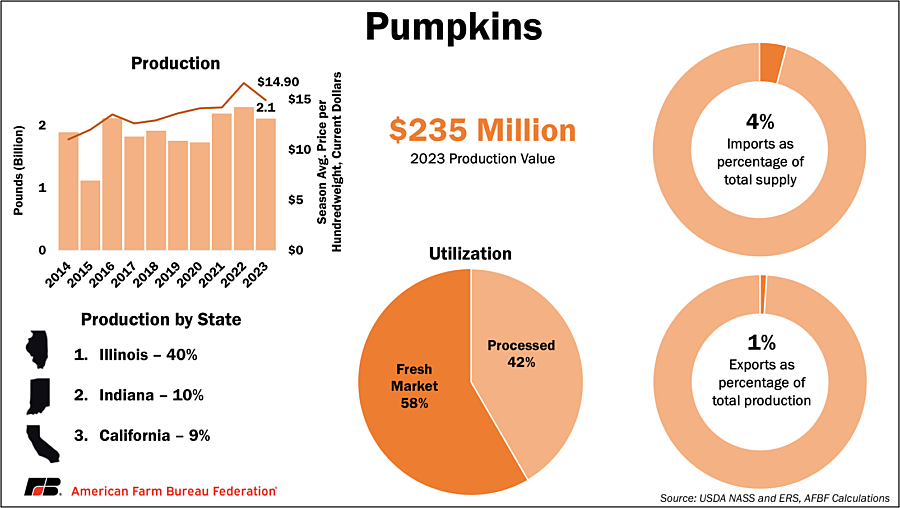
Green Peas
Over 99% of green peas, or “sweet peas”, are used in the processed market, typically either frozen or canned. But just because a product is canned, does not mean that it isn’t fresh. Canning facilities strive to can produce as quickly as possible, with as few as three hours between harvest and canning! Green peas are mostly grown in Washington (36%), Minnesota (33%), Wisconsin (25%) and Oregon (6%).
Green peas are mechanically harvested and separated from their pods in the field, with peas later delivered to a processing facility. Compared to most vegetables, green peas can be grown and processed with relatively little labor – which is why they remain an inexpensive vegetable option.
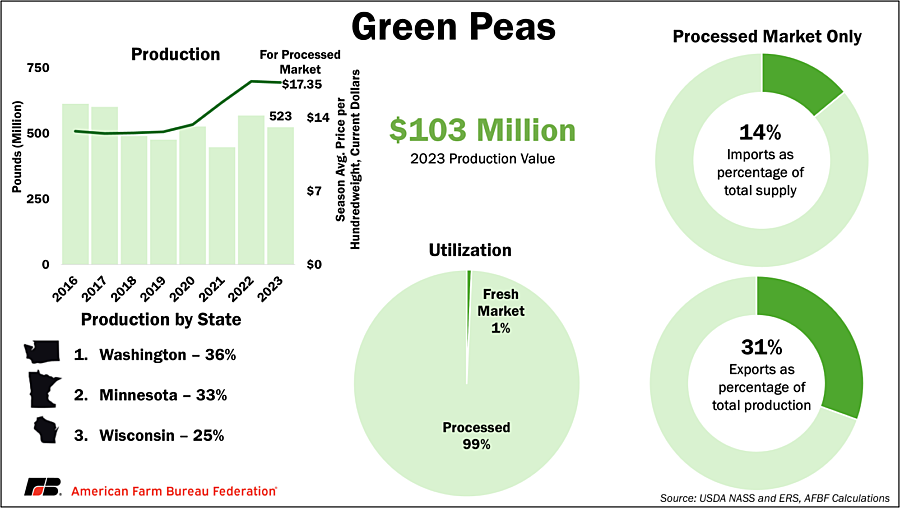
Potatoes
Potatoes are a large and diverse crop, with many different varieties grown for different market segments. For instance, chipping potatoes are used for potato chips with varieties grown for specific characteristics including uniform shape, color, high density, high starch and low sugar (which prevents burnt, black spots in the fryer). Russets, the specific potato featured in AFBF’s expanded Thanksgiving Survey basket, make up the majority of potato acreage nation-wideand are also dominate in the top potato-growing states. These versatile potatoes can be used for both the fresh market – referred to as “table-stock”– or to create frozen fries.
Idaho is synonymous with potatoes for good reason: it produces about one third of all potatoes nationwide. Washington (23%) and Wisconsin (7%) round out the top three, followed by Oregon and North Dakota at 6%; and Colorado, Michigan, Minnesota, Maine, Nebraska, California, Texas and Florida at 5% or less.
Potatoes are grown from seed potatoes, harvested mechanically and can be stored for up to a year in temperature-controlled, humid packing sheds – allowing table-stock potatoes to be enjoyed year-round.
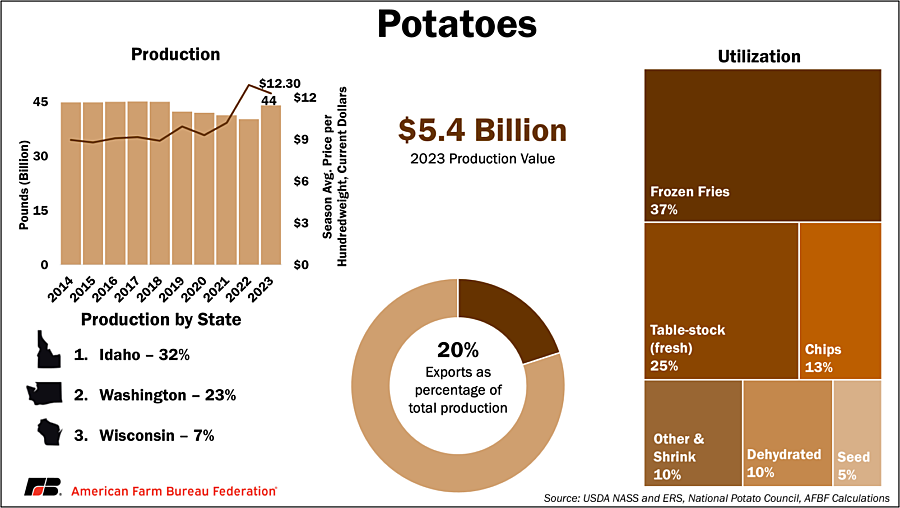
Carrots
Carrots are predominantly a California crop, where they can be grown year-round. Carrots are mechanically harvested, being pulled up by their leafy tops then separated from their tops in the field. At the packing house, they are cooled, cleaned and packaged with many being cut, peeled and polished into baby carrots to be sold at the grocery store – all within 24 hours of harvest.
About 21% of the total fresh market supply is imported, including baby carrots. The number is smaller for processed carrots – about 7% were imported in 2023.

Click here to see more...